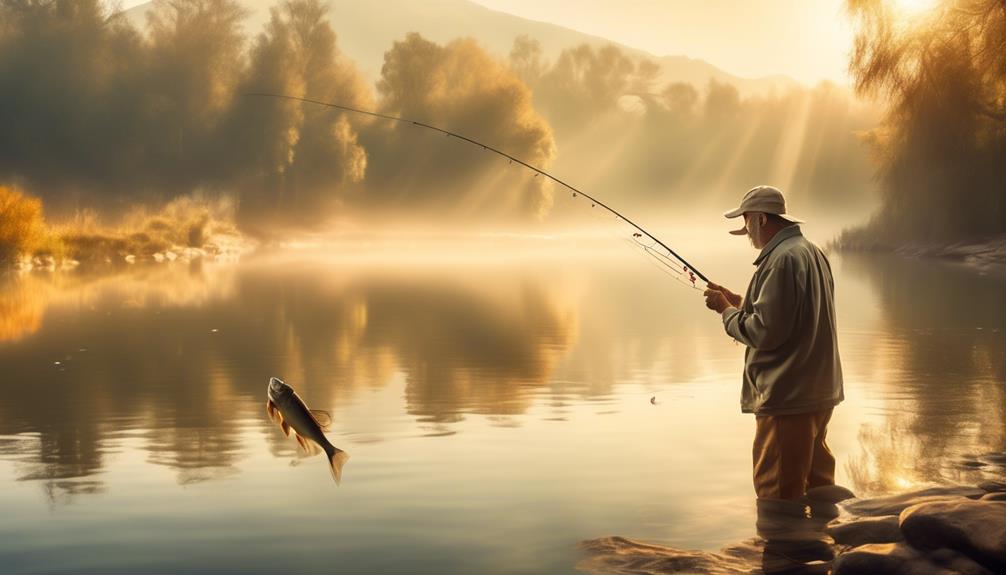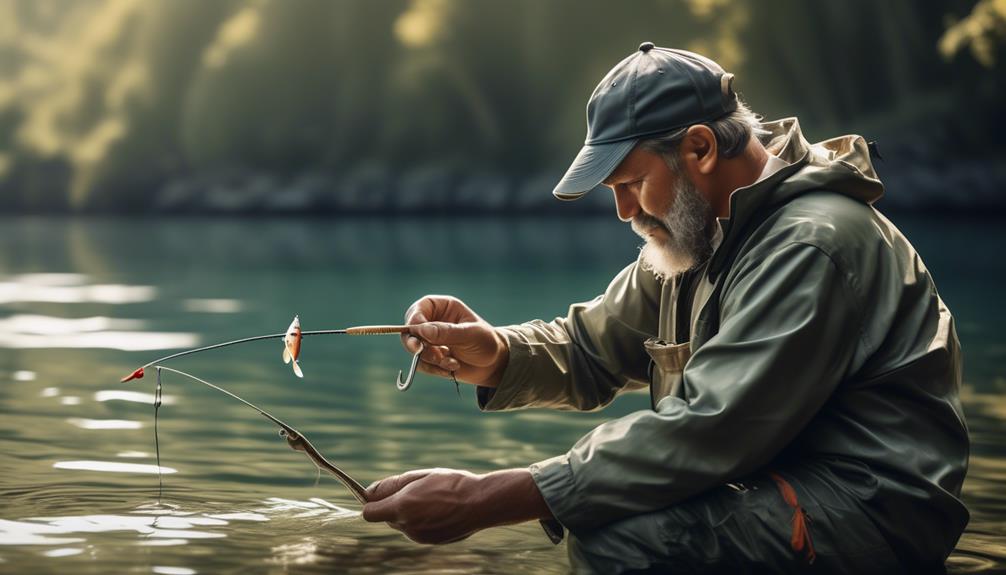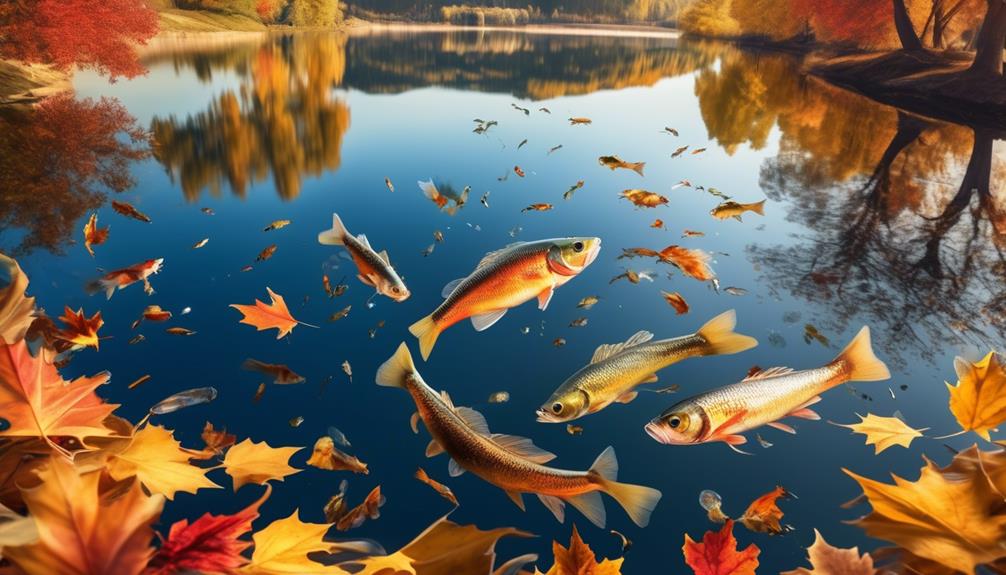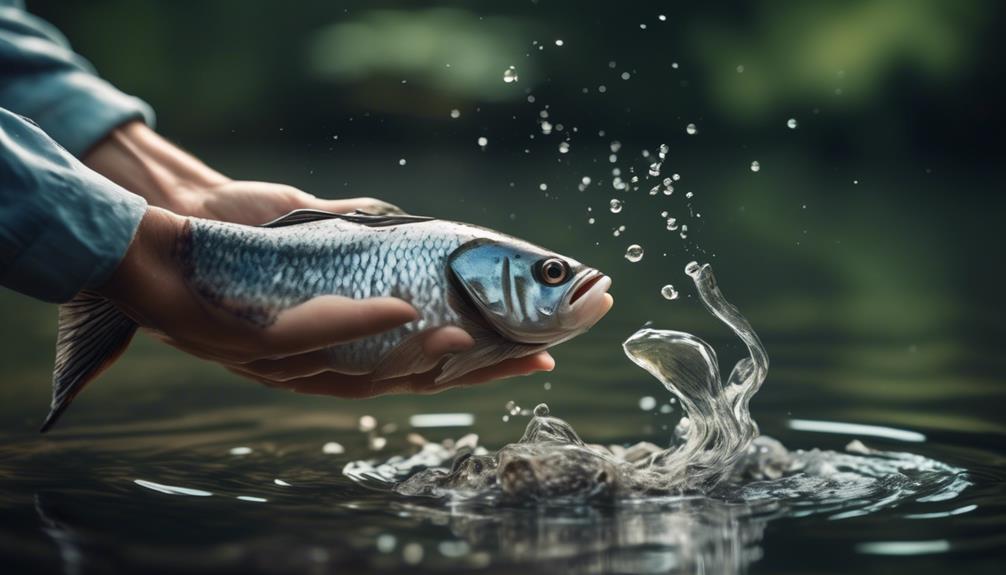Have you ever wondered if catch and release fishing actually makes a difference? The practice has been widely promoted as a conservation method, but does it truly benefit fish populations and the environment?
While the debate continues, it's important to consider the various factors at play and the potential impact of catch and release fishing on both fish and their habitats.
Preserving Fish Populations
To preserve fish populations, practice catch and release fishing to ensure the sustainability of aquatic ecosystems. When you catch and release fish, you play a vital role in preserving habitats and contributing to wildlife management. By releasing the fish back into their natural environment, you allow them to continue their role in the ecosystem, maintaining the delicate balance of aquatic life.
By practicing catch and release fishing, you help maintain healthy fish populations, ensuring that future generations can also enjoy the thrill of fishing. This conservation practice supports the long-term sustainability of fish species, preventing overfishing and bolstering the overall health of aquatic ecosystems. With responsible angling, you can contribute to the preservation of natural habitats and the protection of diverse aquatic wildlife.
Moreover, catch and release fishing contributes to effective wildlife management. It helps in controlling and regulating fish populations, as it allows fish to grow and reproduce, maintaining the natural balance within their environment. This method supports the overall health of fish populations, promoting genetic diversity and resilience in the face of environmental changes. By releasing fish back into the water, you actively participate in the responsible management and conservation of aquatic wildlife.
Sustaining Ecosystem Balance
By practicing catch and release fishing, you actively contribute to sustaining the balance of aquatic ecosystems, ensuring the long-term health of fish populations and their natural habitats. This method supports wildlife management by allowing fish populations to remain at sustainable levels, thus preventing overfishing. Additionally, it promotes ethical angling by minimizing the impact on fish populations, ensuring that future generations can continue to enjoy the sport.
Biodiversity conservation is another crucial aspect of sustaining ecosystem balance through catch and release fishing. By releasing fish back into their natural habitats, anglers help maintain the diversity of species within aquatic environments. This action directly contributes to the protection of aquatic habitats, preserving the delicate balance of these ecosystems and safeguarding the various species that depend on them for survival.
Furthermore, practicing catch and release fishing aids in the protection of aquatic habitats. By allowing fish to be released back into the water, their natural habitats remain undisturbed, thus supporting the overall health of the ecosystem. This approach aligns with the principles of ethical angling, emphasizing the importance of minimizing the environmental impact of the sport on aquatic environments.
Ensuring Future Generations' Enjoyment
For future generations to continue enjoying the sport of fishing, responsible catch and release practices are essential to maintaining healthy fish populations and preserving natural aquatic habitats. By practicing ethical angling and embracing the principles of future conservation, you can play a crucial role in ensuring that the joy of fishing remains an integral part of outdoor experiences for years to come.
Responsible catch and release fishing contributes to future conservation efforts by allowing fish populations to thrive. When you release a fish back into the water carefully, you're giving it the opportunity to reproduce and contribute to the sustainability of its species. This act not only promotes the longevity of various fish populations but also safeguards the delicate balance within aquatic ecosystems, ensuring that future generations can continue to appreciate the beauty of diverse marine life.
Engaging in ethical angling practices, such as using barbless hooks and minimizing the time that a fish is out of water, is fundamental to preserving the well-being of fish. By reducing stress and injury to the fish, you're increasing its chances of survival after being released. Furthermore, respecting catch and release limits and handling fish with care all contribute to nurturing a culture of responsible fishing that will benefit future generations of anglers.
Minimizing Environmental Impact
Minimize the environmental impact of your fishing activities by carefully selecting biodegradable or eco-friendly fishing gear. When it comes to catch and release fishing, using the right gear can significantly reduce stress on fish and promote their survival. Here are some key ways to minimize the environmental impact of your fishing practices:
- Barbless Hooks: Opt for barbless hooks as they're easier to remove, reducing the handling time and potential injury to the fish. This helps in reducing stress and increasing the likelihood of fish survival after release.
- Non-Toxic Weights: Choose non-toxic fishing weights made from materials such as steel or tin. This prevents harmful chemicals from leaching into the water and affecting the aquatic ecosystem, thereby minimizing environmental impact.
- Biodegradable Baits: Consider using biodegradable fishing baits made from natural materials like worms or insects. These baits break down harmlessly in the water, reducing pollution and potential harm to fish and other aquatic organisms.
Supporting Sustainable Fisheries
To further contribute to the health of aquatic ecosystems, consider supporting sustainable fisheries by making informed choices about the seafood you consume. Conservation efforts and ethical fishing practices are essential for the preservation of marine life and the sustainability of fisheries. By choosing seafood from well-managed fisheries, you actively participate in wildlife management and ecological preservation.
Supporting sustainable fisheries involves selecting seafood that's sourced from well-managed, ethical operations. Look for certifications such as Marine Stewardship Council (MSC) or Aquaculture Stewardship Council (ASC) when purchasing seafood. These certifications ensure that the seafood has been sourced in a manner that supports conservation efforts and responsible fishing practices.
Furthermore, it's crucial to be aware of which species are overfished or caught using destructive methods. By avoiding seafood from these sources, you can play a part in promoting sustainable fishing practices. When shopping or dining out, ask about the source of the seafood and the methods used to catch or farm it.
Your choices as a consumer can significantly impact the fishing industry's practices. By supporting sustainable fisheries, you contribute to the long-term health of marine ecosystems and the preservation of fish populations. This, in turn, helps to maintain a balance in the underwater food chain and supports the livelihoods of fishing communities around the world.
Enhancing Angling Opportunities
Exploring ways to expand angling opportunities can lead to a more diverse and enriching fishing experience for both seasoned anglers and newcomers alike. Enhancing angling opportunities not only provides more chances to catch a variety of fish species but also contributes to personal growth and a deeper understanding of the natural world. By actively seeking to improve your angling skills and embracing ethical practices, you can elevate your fishing experiences while contributing to the sustainability of fish populations.
- Participating in Angling Workshops: Engaging in angling workshops or seminars can provide valuable insights into various fishing techniques, equipment usage, and environmental conservation. These opportunities allow you to enhance your skills, learn about responsible angling practices, and connect with like-minded individuals who share a passion for fishing.
- Exploring Diverse Fishing Locations: Venturing beyond familiar fishing spots opens up new possibilities for encountering diverse fish species and experiencing unique angling challenges. Exploring different environments, such as rivers, lakes, and coastal areas, not only expands your angling opportunities but also fosters a deeper appreciation for the interconnectedness of ecosystems.
- Embracing Catch and Release Practices: Adhering to catch and release principles not only supports sustainability but also opens up opportunities for repeated catches. By releasing fish back into their natural habitats, you contribute to the conservation of fish populations and ensure that future generations of anglers can continue to enjoy the thrill of catching these magnificent creatures.
Promoting Conservation Awareness
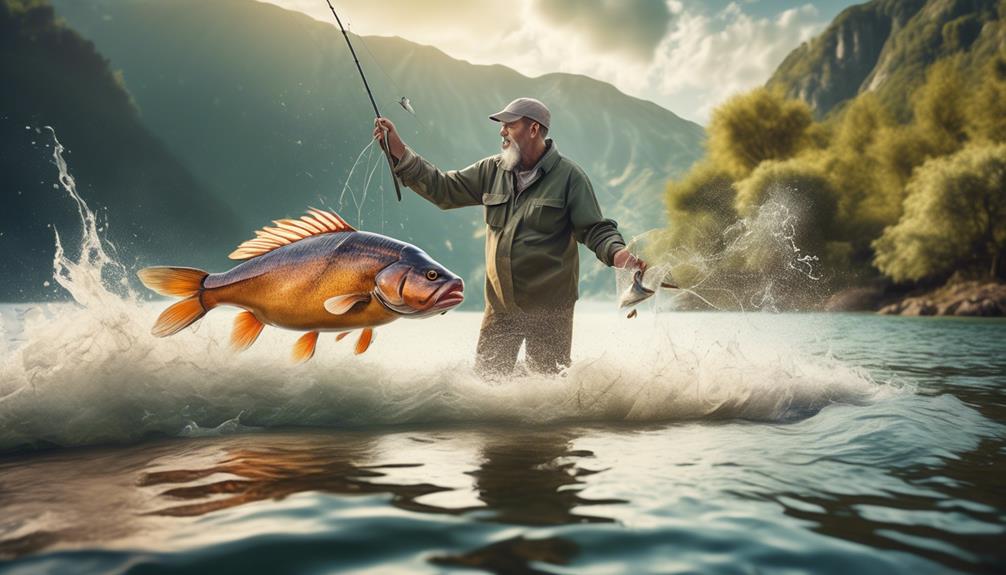
You can amplify your impact on the sustainability of fish populations by actively promoting conservation awareness in your angling community. Conservation education plays a crucial role in ensuring that fish populations remain healthy and abundant for future generations to enjoy. By spreading awareness about ethical angling practices, such as catch and release fishing, you can contribute to the preservation of fish populations and their habitats.
One way to promote conservation awareness is by leading by example. When practicing catch and release fishing, make sure to handle the fish with care, use barbless hooks, and release them quickly to minimize stress. By demonstrating these ethical angling practices, you can show others in your angling community the importance of respecting fish populations and their ecosystems.
Additionally, organizing or participating in conservation education events can have a significant impact. Hosting workshops or seminars on sustainable angling practices, habitat conservation, and the importance of catch and release can help raise awareness among fellow anglers. These events provide opportunities to discuss the benefits of catch and release fishing, including its positive effects on fish populations and the overall health of aquatic environments.
Furthermore, utilizing social media and online platforms to share information about conservation and ethical angling practices can reach a broader audience. By posting about successful catch and release experiences, highlighting conservation tips, and sharing relevant articles, you can engage with and educate a wider community of anglers about the importance of conservation awareness in fishing.
Improving Fish Health
Improving fish health requires monitoring water quality, managing fish populations, and minimizing environmental stressors. By focusing on these aspects, you can significantly contribute to the overall well-being of fish populations.
- Monitoring Water Quality: Regularly testing the water for pH levels, dissolved oxygen, and pollutants is crucial for ensuring a healthy aquatic environment. By maintaining optimal water conditions, you can help improve fish habitat and support their growth and reproduction.
- Managing Fish Populations: Implementing size and bag limits, as well as seasonal fishing closures, can help control fish populations. This management strategy ensures that fish aren't overexploited, allowing them to thrive and maintain a balanced ecosystem.
- Minimizing Environmental Stressors: Reducing stressors such as habitat destruction, pollution, and invasive species can greatly enhance fish health. Preserving natural habitats and minimizing human impact on aquatic ecosystems are essential for creating a conducive environment for fish to thrive.
Improving fish health isn't only beneficial for the well-being of fish populations but also contributes to the overall ecological balance of aquatic ecosystems. By actively participating in efforts to improve fish habitat and reduce stressors, you can play a significant role in promoting the sustainability of fish populations for future generations.
Frequently Asked Questions
How Can Catch and Release Fishing Contribute to the Local Economy?
Catch and release fishing contributes to the local economy in multiple ways. Firstly, it has a positive economic impact by attracting tourists to the area. When anglers release fish back into the water, it helps sustain the fish population. This, in turn, attracts more visitors who are interested in fishing. The increase in tourism brings in revenue for local businesses such as hotels, restaurants, and tackle shops. Moreover, catch and release fishing supports jobs in the tourism and recreational fishing sectors.
Is Catch and Release Fishing Suitable for All Types of Fish Species?
Catch and release fishing can be suitable for all types of fish species, contributing to species conservation and reducing the impact of fishing on fish populations and the environment.
By releasing the fish back into their natural habitat, you can help maintain healthy populations and protect the ecosystem.
This practice is especially important for vulnerable or endangered species, ensuring their survival for future generations.
What Are the Best Practices for Handling Fish During Catch and Release to Ensure Their Survival?
When you catch and release fish, proper handling is crucial for their survival rates.
Ensure you wet your hands before handling the fish to protect their slimy coating.
Use barbless hooks to minimize damage and avoid unnecessary stress.
Keep the fish in the water as much as possible and avoid squeezing their bodies.
Are There Any Regulations or Guidelines for Catch and Release Fishing in Different Regions?
Regulations and guidelines for catch and release fishing vary by region, reflecting conservation efforts and sustainability practices. These rules often address the use of barbless hooks, proper handling techniques, and allowable fishing areas.
Can Catch and Release Fishing Help in Maintaining Genetic Diversity Within Fish Populations?
To maintain biodiversity, conservation efforts can benefit from catch and release fishing. By releasing fish back into their natural habitat, you allow them to contribute to genetic diversity within their populations. This practice helps sustain healthy fish populations and supports the overall ecosystem.
Additionally, it promotes sustainable fishing practices, ensuring that future generations can continue to enjoy recreational fishing while preserving the natural balance of aquatic environments.
Conclusion
So next time you're out fishing, remember the benefits of catch and release.
By preserving fish populations, sustaining ecosystem balance, and minimizing environmental impact, you're ensuring future generations can enjoy the sport as well.
Plus, you're supporting sustainable fisheries and promoting conservation awareness.
It's a win-win for both anglers and the environment.
Keep practicing catch and release for healthier fish populations and a more sustainable fishing future.
